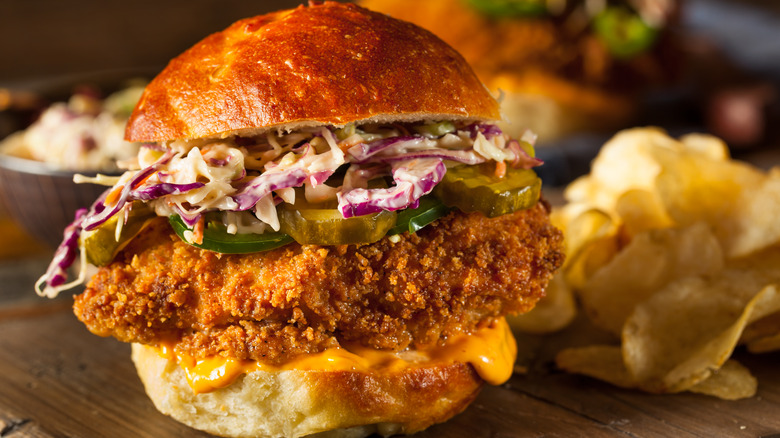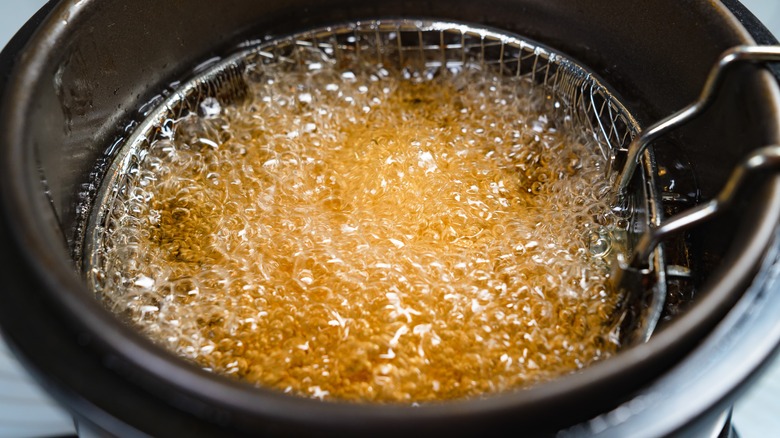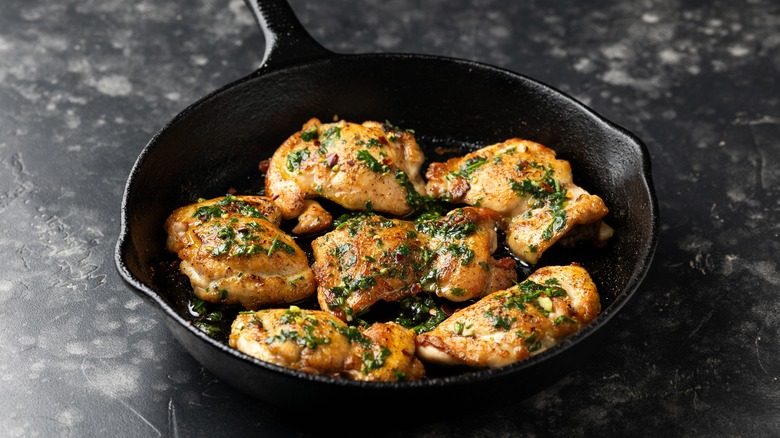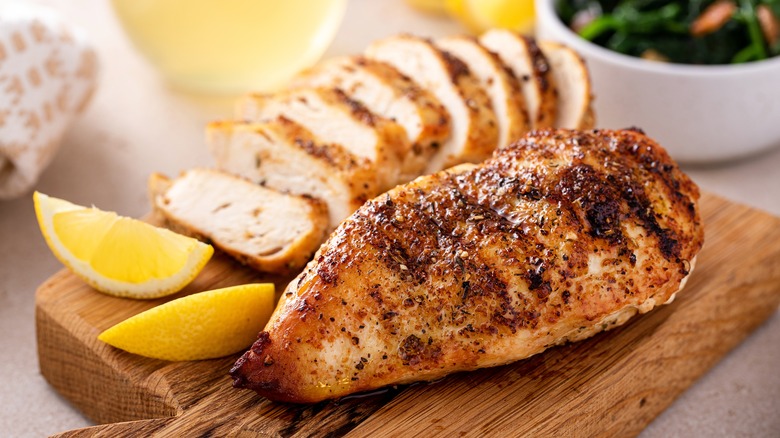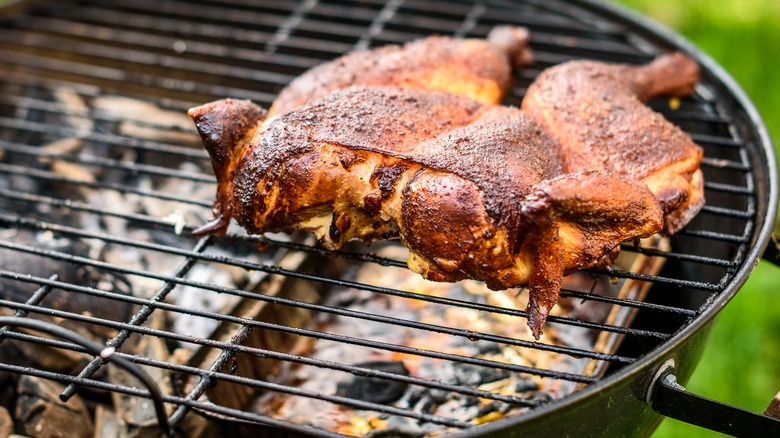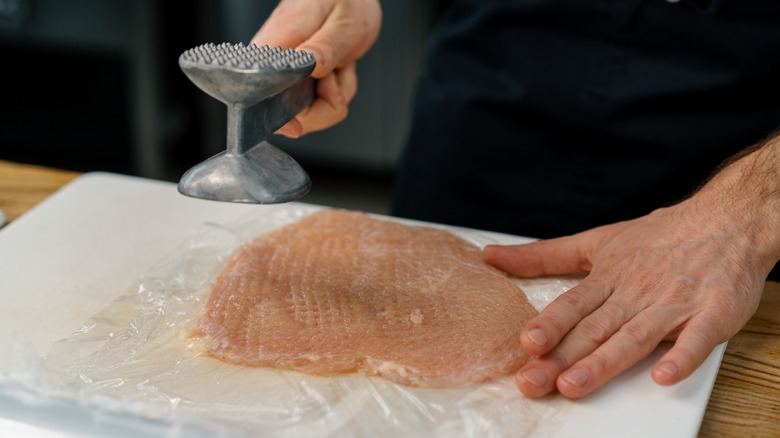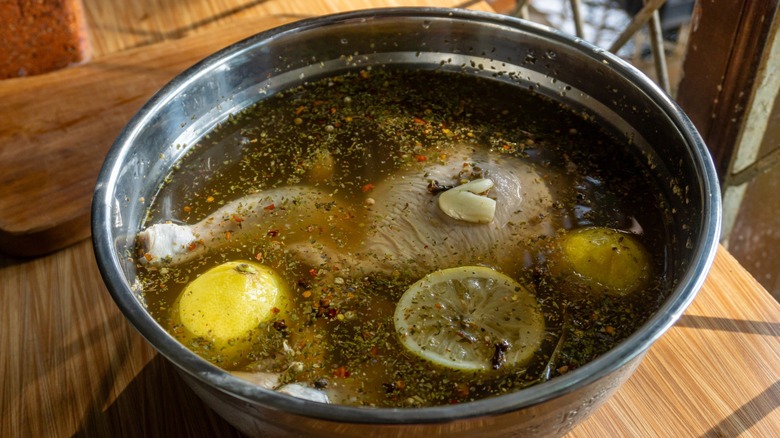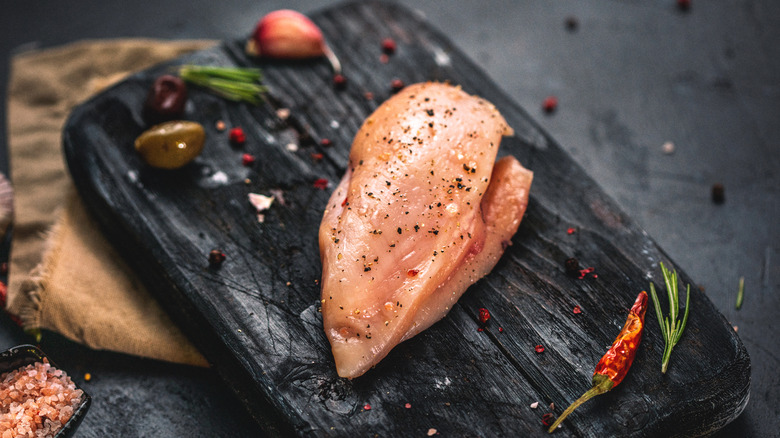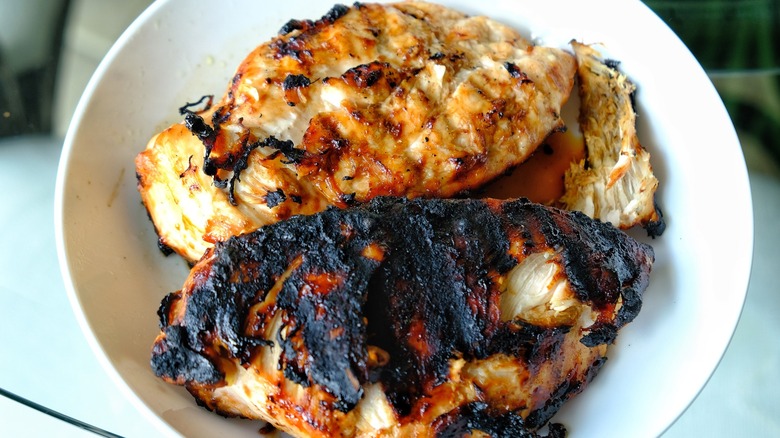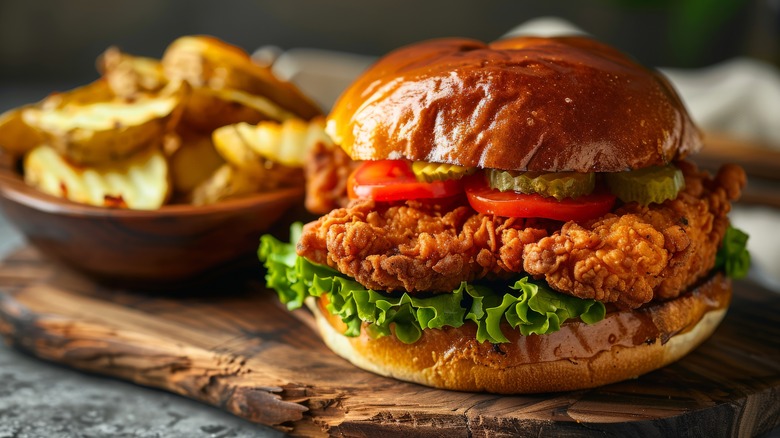9 Big Mistakes To Avoid When Making A Chicken Sandwich
Making a really good chicken sandwich is a basic kitchen skill that everyone can master with some practice. After working the grill station in kitchens for years, it's safe to say that I've made my fair share of chicken sandwiches. And in that time, I've learned how to consistently deliver delicious results.
On the surface, making a chicken sandwich may seem relatively easy — and while that's true to some degree, the reality is that a lot of mistakes can happen along the way. These mistakes can end up ruining your chicken sandwich or, at the very least, hold it back from reaching its delicious potential.
The good news is that you can steer clear of those blunders. Most of these tips really come down to flavoring methods and timing, but there are also a few kitchen tools that can help you along the way. After you've read these tips, you should be able to whip up an extra juicy and super flavorful chicken sandwich that hits the spot every time.
1. Not checking the temperature of your frying oil
This tip comes into play when you're making fried chicken sandwiches. The main goal when making a fried chicken sandwich is to ensure that the outside crust is nice and crispy and the inside of the chicken is properly cooked. While the thickness of the chicken is also a major factor to consider here, the most important variable at play is the temperature of the oil that you're cooking. People who don't know any better can see bubbles rising to the surface of the oil and mistakenly assume that the oil is ready. But just because the oil is bubbling doesn't necessarily mean that it's the right temperature to cook your chicken.
Here's where it gets a little tricky. The ideal oil temperature is 350 degrees Fahrenheit. But guess what happens when you plunge that big hunk of cold chicken into the fryer? The cold chicken immediately cools down the oil around it, causing the oil to drop in temperature and possibly dip below 350 degrees Fahrenheit. And, if the oil isn't hot enough, you'll end up with a mushy chicken sandwich.
For this reason, I often wait for the oil to hit around 400 degrees Fahrenheit. That way, when the temperature of the oil inevitably drops when the cold chicken is submerged, the oil ends up at about 350 degrees Fahrenheit. Instead of eyeballing your fryer oil, get yourself a digital thermometer so that you can accurately read the temperature.
2. Crowding the chicken in the pan
Crowding the pan is a common misstep in the cooking world. When you're feeding a crowd, it may seem like a good idea to cram as much chicken as you can into the pan, but the truth is that this seemingly more productive approach can end up backfiring. The problem is that when chicken (or pretty much any ingredient) is crowded into a pan, the steam around it has more trouble escaping. This ends up causing moisture to build up around the chicken, which drips back down onto the hot pan and creates more steam. The excess moisture ends up steaming the chicken, which hinders the development of texture and a delicious crust. To make a great chicken sandwich, we want to create an atmosphere in the pan that's conducive to searing and developing a flavorful crust, but that's not possible if the pan is overcrowded.
Rather than cramming as much chicken as you possibly can into the pan, make sure each piece of chicken has some extra space around it. The extra space will allow steam more room to evaporate, and the pan will maintain more heat to sear into the chicken and develop more flavor and texture. If you want to achieve similar results to some of your favorite fast food grilled chicken sandwiches, this is a good tip to keep in mind.
3. Flipping the chicken too soon
Whether you're cooking on a grill or in a cast iron skillet, flipping too soon is a big mistake. That said, I get it: You're hungry and you're eager to move things along, so flipping those pieces of chicken as soon as possible feels like a good way to speed things up. But the reality is that approach is not really going to save you much time. Perhaps more importantly, if you flip the chicken too soon it doesn't allow the chicken enough time to properly brown a bit and develop flavor.
Rather than flipping your chicken too early, let it be for a while, until the bottom starts to develop some color. You can usually tell that it's ready when the sides of the chicken are starting to cook. If you're not sure if it's ready to flip, take your tongs and gently lift it up to take a peek. When the bottom is golden brown, you're good to go.
4. Forgetting to butterfly the chicken
If you're working with chicken breasts — which tend to be thicker on one side and thinner on the other — butterflying the chicken will level it out so that it's flat and cooks more evenly. Butterflying chicken is easy: All you have to do is carefully cut down the center of the chicken, leaving it still connected on one side rather than completely cutting it in half. When you're done slicing it, the chicken breast will be divided into two wing-like shapes — hence the term "butterfly."
If you don't butterfly the chicken and leave the chicken breast as is, what often happens is that the thinner side cooks much faster than the thicker side. By the time the thicker side is fully cooked through, the thinner side is overcooked and tough. And no one wants to eat a chicken sandwich that's overcooked and tough. Butterflying your chicken breasts is an easy way to ensure that they're evenly cooked and make a great batch of chicken sandwiches.
5. Not tenderizing the chicken
Tenderizing meat refers to preparation methods that make it more succulent. If you're cooking chicken thighs, this doesn't really need to be done, because chicken thighs contain enough fat to keep the meat moist. But if you're working with chicken breasts — which contain less fat — then tenderizing your chicken is a good idea.
There are a number of approaches that you can use to accomplish this, but the easiest way is using a meat mallet. A meat mallet is a kitchen tool that's typically made of metal. It has a handle on one end and a heavy square on the other. The squared end usually has a flat side and a spiked side. By gently tapping the squared end of the mallet down on the chicken, it loosens up the meat to make it more tender.
There are two important things to remember here. First: don't overdo it. You don't want to beat the chicken into total mush; you just want to soften it up. Second, make sure to cover your chicken with plastic wrap before you tenderize it with the meat mallet — this will prevent splatter. Aside from tenderizing, we have a lot more tips for cooking chicken breasts for you to check out.
6. Forgetting to brine the chicken
No matter how you're cooking chicken, soaking the chicken in brine will make it more tender and flavorful. If you haven't ever brined chicken before, the good news is that it's very easy. For the uninitiated, a brine is a liquid solution that's used to flavor food (think: pickle brine). Brine recipes can vary. Ideally, brining should be done a day before cooking, so that the chicken has enough time to soak up the brine.
If you're frying the chicken, try soaking it in a brine made with buttermilk, a little pickle juice, and a few splashes of hot sauce. The buttermilk will give the flour something viscous to cling to, which makes a great breading once it's fried golden brown. If you're grilling chicken, try soaking it in a simple brine made with water, brown sugar, salt, crushed garlic cloves, and some toasted peppercorns. Be sure to pat the chicken dry thoroughly before grilling. Brining your chicken is easy to do and it will make your chicken sandwich even more juicy and tasty. Feel free to get creative and experiment with different brines. If you're looking for some inspiration, we've got you covered with the 12 best liquids for brining chicken.
7. Underseasoning the chicken
Part of the reason that chicken is so popular is because it has a neutral flavor that can easily adapt to just about every type of cuisine imaginable. And while that kind of versatility certainly has its advantages, chicken's inherently mild flavor also means that seasoning it is extra important.
Cooking is all about maximizing flavor. At every stage of the cooking process, we want to think about ways to infuse flavor into the ingredients that we're working with. Underseasoning chicken for your sandwich will lead to mediocre results. And we're not aiming for mediocre, right? We're aiming for delicious.
By making sure that every inch of the chicken is well-seasoned, you're ensuring it will be super flavorful. Equally important is the seasoning rub that you use. I'd recommend making a simple all-purpose seasoning rub made with salt, pepper, garlic powder, sugar, smoked paprika, and dried oregano. The rub should taste savory, a little smoky, and have a touch of herby sweetness for balance. Let the seasoning marinade into the chicken at least 15 minutes before cooking.
8. Overcooking the chicken
Many people are deathly afraid of eating undercooked chicken (and rightfully so), so they overcompensate by scorching it into oblivion to make absolutely sure that it's done. The problem with this approach is that overcooking the chicken makes it tough and dry — which is the complete opposite of what we're trying to achieve with our chicken. We want tender, juicy chicken for our sandwiches.
This is another area of cooking where a digital thermometer comes in handy — you can avoid overcooking your chicken by using one. When you think the chicken is just about done, insert the thermometer into the thickest part of the chicken and check the temperature. We're aiming for a minimum of 165 degrees Fahrenheit. The higher the temperature goes from there, the more cooked, tough, and dry the chicken will become. Your chicken (and every other meat that you cook) will end up much juicier if you can accurately gauge its temperature. Another secret to cooking perfect, juicy chicken breasts is letting the chicken rest so that the inner juices have some time to settle.
9. Not toasting the bun correctly
It's easy to overlook the importance of the bun for your chicken sandwich. When you're focused on tenderizing, brining, seasoning, and cooking the chicken to perfection, the bun may seem far less important. But the bun literally holds everything together, and the texture can either make or break the sandwich. Ever bite into a chicken sandwich on a mushy bun? Not very appetizing, is it? On the other hand, biting into a burned bun is equally unpleasant. We want to strike a balance between these extremes, toasting the bun just enough until it's lightly golden.
Ideally, the edges of the bun should be lightly crispy, but the interior of the bread should still retain some cushiness. My favorite way to toast buns is by spreading a light layer of mayo on, then toasting them on my cast iron skillet. The trick here is getting the cast iron skillet nice and hot before laying the buns down so that it starts toasting right away. Just keep your eyes on the prize and make sure the buns don't burn. Pro tip: Try to have everything else for your sandwich ready to go so that the bun is still warm for your first bite.
